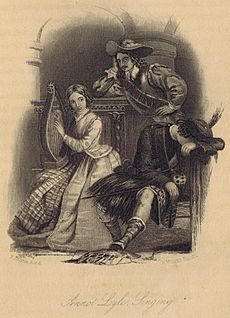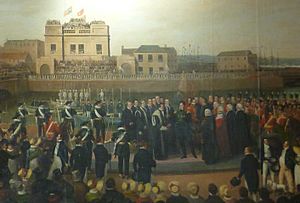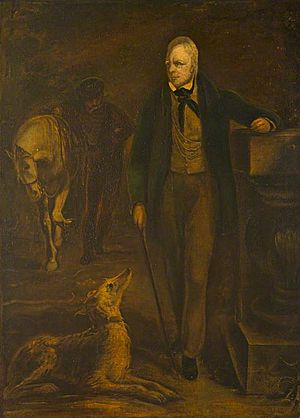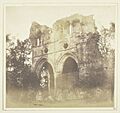Walter Scott facts for kids
Quick facts for kids
Walter Scott
|
|
|---|---|
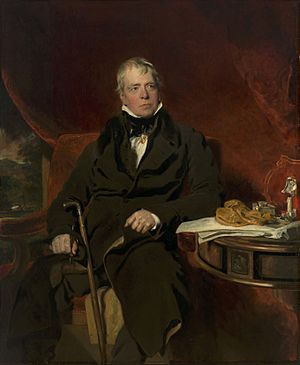
Portrait by Thomas Lawrence, c. 1820s
|
|
| Born | 15 August 1771 Edinburgh, Scotland |
| Died | 21 September 1832 (aged 61) Abbotsford, Roxburghshire, Scotland |
| Occupation |
|
| Alma mater | University of Edinburgh |
| Period | 19th century |
| Literary movement | Romanticism |
| Spouse | Charlotte Carpenter (Charpentier) |
| Children | 5 |
| Signature | |
 |
|
Sir Walter Scott (born August 15, 1771 – died September 21, 1832) was a famous Scottish writer. He was a historian, novelist, poet, and playwright. Many of his books are still popular today in Europe and Scotland. Some of his most famous novels include Ivanhoe (1819), Rob Roy (1817), and Waverley (1814). He also wrote well-known poems like Marmion (1808) and The Lady of the Lake (1810). Scott had a big impact on literature in Europe and America.
Besides writing, he worked as a lawyer and judge. He was also involved in important societies in Edinburgh. Scott helped create the historical novel style of writing. This made him a key figure in the Romanticism movement. In 1820, he was given the title of baronet, becoming Sir Walter Scott.
Contents
- Early Life and Childhood
- Becoming a Student and Lawyer
- Writing Career and Family Life
- The Famous Poet
- The Novelist
- Crown Jewels, Knighthood, and Royal Visit
- Financial Troubles and Death
- Religion and Freemasonry
- Abbotsford House
- His Lasting Fame
- Influence on Other Writers and Arts
- Works by Walter Scott
- Images for kids
- See also
Early Life and Childhood
Walter Scott was born on August 15, 1771, in Edinburgh, Scotland. He was the ninth child in his family, but six of his older brothers and sisters had died young. His father, Walter Scott, was a lawyer. His mother was Anne Rutherford.
When Walter was two years old, he got polio. This illness left him with a limp, which affected him his whole life. To help him get better, he was sent to live on his grandparents' farm in the Scottish Borders. This farm was near the old Smailholm Tower.

While at the farm, his aunt Jenny taught him to read. She also told him many old Scottish stories and legends. These tales later inspired much of his writing. He returned to Edinburgh in 1775 and later went to school there. He loved reading books about knights, poems, history, and travel.
In 1783, his parents sent him to stay with his aunt Jenny again in Kelso. There, he met James and John Ballantyne, who later became his business partners and printers.
How Walter Scott Looked
Because of his childhood polio, Scott had a noticeable limp. In 1820, people described him as tall and well-built, except for his foot. He had a high forehead, a short nose, and clear blue eyes. His hair was white. Even with his limp, he loved to walk and ride horses.
Becoming a Student and Lawyer
Scott started studying at the University of Edinburgh in November 1783, when he was 12. In 1786, he began training to become a lawyer in his father's office.
At university, Scott became friends with Adam Ferguson. He also met the blind poet Thomas Blacklock, who lent him books. During this time, a 15-year-old Scott met the famous Scottish poet Robert Burns. This was their only meeting.
Scott decided to become a lawyer. He went back to university to study law. He became very active in student groups, helping to start the Literary Society in 1789. In 1792, he became a lawyer in Edinburgh.
In 1797, Scott joined the Royal Edinburgh Volunteer Light Dragoons. This was because people worried about a French invasion. He took his role seriously, even waking up at 5 a.m. for daily drills.
Writing Career and Family Life
Scott started his writing career because he loved German literature in the 1790s. He translated German poems into English. He was also very interested in old Scottish songs and stories. He collected many traditional ballads and published them in a two-volume book called Minstrelsy of the Scottish Border in 1802. This book was very important because it published many old songs for the first time.
In 1797, Scott met Charlotte Charpentier while on a trip. After a short time, they decided to get married on Christmas Eve in Carlisle. They lived in Edinburgh and had five children, though only four lived longer than Scott.
In 1799, Scott became a judge in Selkirkshire. His income from being a lawyer, judge, and his wife's money helped them live comfortably.
In 1801, the Scotts moved to a larger house at 39 North Castle Street in Edinburgh. This was his main home in the city until 1826. For summers, he rented a cottage in Lasswade, where he started his career as an author. In 1804, he moved to a bigger house called Ashestiel, which was closer to his work as a judge.
Scott worked closely with his friend James Ballantyne, who was a printer. In 1805, they became business partners. Ballantyne's company printed all of Scott's books until 1826.
Scott loved dogs and had many throughout his life. His most famous dogs were Maida, a large stag hound, and Spice, a small terrier. He cared deeply for his dogs, even when he faced financial problems.
The Famous Poet
Between 1805 and 1817, Scott wrote many long poems. He was the most popular poet of his time until Lord Byron became famous in 1812.
His first long poem, The Lay of the Last Minstrel (1805), was a medieval romance. It used stories and legends from the Scottish Borders. The poem was a huge success and sold many copies.
Three years later, he published Marmion (1808). This poem told a story of love and betrayal, ending with the Battle of Flodden in 1513. The publisher bought the rights to the poem for a lot of money even before it was finished. It sold 8,000 copies in its first year. A famous line from this poem is: "O what a tangled web we weave,/ When first we practice to deceive."
Scott's most popular poem was The Lady of the Lake (1810). It sold 20,000 copies in its first year. This poem made the Perthshire Highlands a popular place for tourists. It also explored the idea of different societies clashing, which became a key theme in his later novels.
Scott was also a reviewer for newspapers. He helped start The Quarterly Review, a newspaper that supported the Tory political party. In 1813, he was offered the job of Poet Laureate, a special poet for the King. But he turned it down because he wanted to keep his freedom as a writer.
The Novelist
Scott's journey to becoming a novelist was not straightforward. He started writing Waverley around 1805 but stopped after a friend didn't like it. He picked it up again in 1813, and it was published in 1814. It was an instant success! Waverley was the first of 27 novels he would write.
Scott published his novels without his name on them at first. They often said "By the Author of Waverley." Everyone knew it was him, but he kept it a secret for a while.
Most of Scott's novels are historical. Only one, Saint Ronan's Well, is set in modern times. Sixteen of his novels take place in Scotland. His early Scottish novels, like Waverley and Old Mortality, are very well-known. They show different sides of Scottish history, like the Jacobite rebellions and the Covenanters.
In 1820, Scott changed his setting and wrote Ivanhoe, which takes place in 12th-century England. This book is still his most famous work and is often read today. He also wrote about 17th-century England in novels like Kenilworth.
Scott believed that people's feelings and actions are the same throughout history, even if their societies change. He showed how different times and places had the same human emotions. This helped his readers connect with characters from the past.
Scott didn't plan his stories in great detail. He often said that his characters and events grew as he wrote. He would send parts of his manuscript to be copied and printed as he went along.
Later in his life, Scott created a special collection of his novels called the 'Magnum Edition'. He added introductions and notes to each book. These books were sold cheaply and became very popular, selling 30,000 copies each month.
Scott's novels helped English readers understand Scottish people better. In his Scottish novels, characters from the lower classes often speak in Scots dialect. Scott made sure the dialect wasn't too hard to understand for those who didn't know it.
Even as a novelist, Scott continued to write poetry. His novels often include original songs and poems.
Crown Jewels, Knighthood, and Royal Visit
Scott helped find the Scottish Crown Jewels. These jewels had been hidden away for a long time and many thought they were lost. In 1818, Scott and a team opened a locked box in Edinburgh Castle and found them!
Because of his efforts, King George IV gave Scott the title of baronet in 1820. He became Sir Walter Scott.
In 1822, Scott helped organize a big event for King George IV's visit to Scotland. Scott planned a huge celebration to impress the King and bring Scottish people together. He had the King wear tartan, and many people wore tartan too. This helped make tartan a strong symbol of Scottish identity.
Financial Troubles and Death
In 1825, a banking crisis caused the printing business Scott was part of to collapse. He owed a lot of money, about £130,000. Instead of declaring bankruptcy, Scott decided to write more books to pay off his debts. He put his house and income into a trust for his creditors. This was a very difficult time for him, and his wife Charlotte died in 1826.
Despite these challenges, Scott kept writing a lot. Between 1826 and 1832, he wrote six novels, many non-fiction books, and a journal. His non-fiction included a book about Napoleon Buonaparte and a series of stories for children called Tales of a Grandfather.
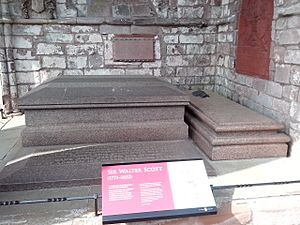
Scott's health began to fail. In 1831, he traveled to Malta and Naples hoping to feel better. He was welcomed everywhere he went. On his way home, he had a final stroke. He returned to his home, Abbotsford, and died on September 21, 1832, at age 61.
Scott was buried next to his wife at Dryburgh Abbey. Even though he died owing money, his books continued to sell well. All his debts were paid off shortly after his death.
Religion and Freemasonry
Scott grew up as a Presbyterian in the Church of Scotland. Later in life, he also followed the Scottish Episcopal Church. He didn't go to church often but read prayers at home with his family.
Scott's father was a Freemason, and Walter Scott also became a Freemason in 1801.
Abbotsford House

In 1811, Scott bought a farm called Cartley Hole. He renamed it "Abbotsford" after a nearby river crossing used by monks. He expanded the farmhouse into a large, beautiful home. Scott called it "a sort of romance in Architecture."
Abbotsford House was built in the Scottish Baronial style, with towers and fancy gables. Inside, it had suits of armor, hunting trophies, a library with over 9,000 books, and beautiful paintings. It cost him a lot of money to build and decorate.
His Lasting Fame

Even though his popularity changed over time, Scott is still important. He is known as the inventor of the modern historical novel. He inspired many other writers in Britain and Europe.
Scott's novels also helped change how people viewed the Scottish Highlands. Before his books, the Highlands were often seen as wild and dangerous. Scott's stories helped people see the beauty and history of Scottish culture. He showed that past conflicts belonged to history, helping Scotland move towards a more peaceful future.
Today, Scott is seen as a very important writer. He not only created the historical novel but also wrote with great depth and skill, entertaining and challenging his readers.
Memorials and Tributes
Many places remember Sir Walter Scott. In Edinburgh, there is a very tall Gothic tower called the Scott Monument. It was finished in 1844, after his death, and is a famous landmark. Waverley railway station in Edinburgh is named after his first novel.

In Glasgow, there is also a large monument to Walter Scott in George Square. There is even a statue of him in Central Park in New York City.
The annual Walter Scott Prize for Historical Fiction was created in 2010. It is a big award for historical novels and is given out at Abbotsford House.
Scott is also famous for helping to save the Scottish banknote. In 1826, the government wanted to stop Scottish banks from printing small banknotes. Scott wrote letters arguing against this, and the government changed its mind. Because of this, his picture is still on the front of all notes issued by the Bank of Scotland.
His book Ivanhoe was required reading for many American high school students until the 1950s. Many streets in Vancouver, British Columbia are named after his books and characters.
Influence on Other Writers and Arts
Walter Scott had a huge impact on writers across Europe. His historical novels made people see the past as a place where people lived and felt differently. Writers like Balzac, Tolstoy, and Dumas were influenced by him.
Many other British writers, including Robert Louis Stevenson, were also inspired by Scott. He even shaped children's writers like Charlotte Yonge.
Edgar Allan Poe loved Scott's novel The Bride of Lammermoor, calling it "the master novel of Scott."
Even Mark Twain, who sometimes made fun of Scott's influence, named a sinking boat the "Walter Scott" in Adventures of Huckleberry Finn.
Scott's stories also inspired many composers. About 90 operas are based on his poems and novels. Famous examples include Rossini's La donna del lago (based on The Lady of the Lake) and Donizetti's Lucia di Lammermoor (based on The Bride of Lammermoor).
Many of Scott's songs were set to music. Schubert set seven songs from The Lady of the Lake to music, including the famous 'Schubert's Ave Maria'. Artists also painted many scenes from his novels.
Works by Walter Scott
Novels
The Waverley Novels is the name for Scott's long series of novels. It is named after his first novel, Waverley.
- 1814: Waverley
- 1815: Guy Mannering
- 1816: The Antiquary
- 1816: The Black Dwarf and Old Mortality
- 1817: Rob Roy
- 1818: The Heart of Mid-Lothian
- 1819: The Bride of Lammermoor and A Legend of Montrose
- 1819 (dated 1820): Ivanhoe
- 1820: The Monastery
- 1820: The Abbot
- 1821: Kenilworth
- 1822: The Pirate
- 1822: The Fortunes of Nigel
- 1822: Peveril of the Peak
- 1823: Quentin Durward
- 1824: St. Ronan's Well
- 1824: Redgauntlet
- 1825: The Betrothed and The Talisman
- 1826: Woodstock
- 1827: Chronicles of the Canongate (includes "The Highland Widow" and "The Two Drovers")
- 1828: The Fair Maid of Perth
- 1829: Anne of Geierstein
- 1832: Count Robert of Paris and Castle Dangerous
Poetry
Many of Scott's short poems were part of his longer works.
- 1796: The Chase, and William and Helen
- 1800: Glenfinlas
- 1802–1803: Minstrelsy of the Scottish Border
- 1805: The Lay of the Last Minstrel
- 1808: Marmion
- 1810: The Lady of the Lake
- 1811: The Vision of Don Roderick
- 1813: The Bridal of Triermain
- 1813: Rokeby
- 1815: The Field of Waterloo
- 1815: The Lord of the Isles
- 1817: Harold the Dauntless
- 1825: Bonnie Dundee
Short Stories
- 1827: "The Highland Widow" and "The Two Drovers"
- 1828: "My Aunt Margaret's Mirror", "The Tapestried Chamber", and "Death of the Laird's Jock"
Plays
- 1799: Goetz of Berlichingen (a translation)
- 1822: Halidon Hill
- 1823: MacDuff's Cross
Non-fiction
- 1825–1832: The Journal of Sir Walter Scott
- 1827: The Life of Napoleon Buonaparte
- 1828: Tales of a Grandfather; Being Stories Taken from Scottish History (1st part)
- 1829: The History of Scotland: Volume I
- 1829: Tales of a Grandfather; Being Stories Taken from Scottish History (2nd part)
- 1830: The History of Scotland: Volume II
- 1830: Tales of a Grandfather; Being Stories Taken from Scottish History (3rd part)
- 1830: Letters on Demonology and Witchcraft
- 1831: Tales of a Grandfather; Being Stories Taken from the History of France (4th part)
Images for kids
-
The Scott family's home in George Square, Edinburgh, from about 1778.
-
Tomb of Walter Scott, in Dryburgh Abbey, photo by Henry Fox Talbot, 1844.
-
Statue by Sir John Steell on the Scott Monument in Edinburgh.
See also
 In Spanish: Walter Scott para niños
In Spanish: Walter Scott para niños
- Jedediah Cleishbotham (a fictional editor Scott used)
- People on Scottish banknotes
- Writers' Museum




